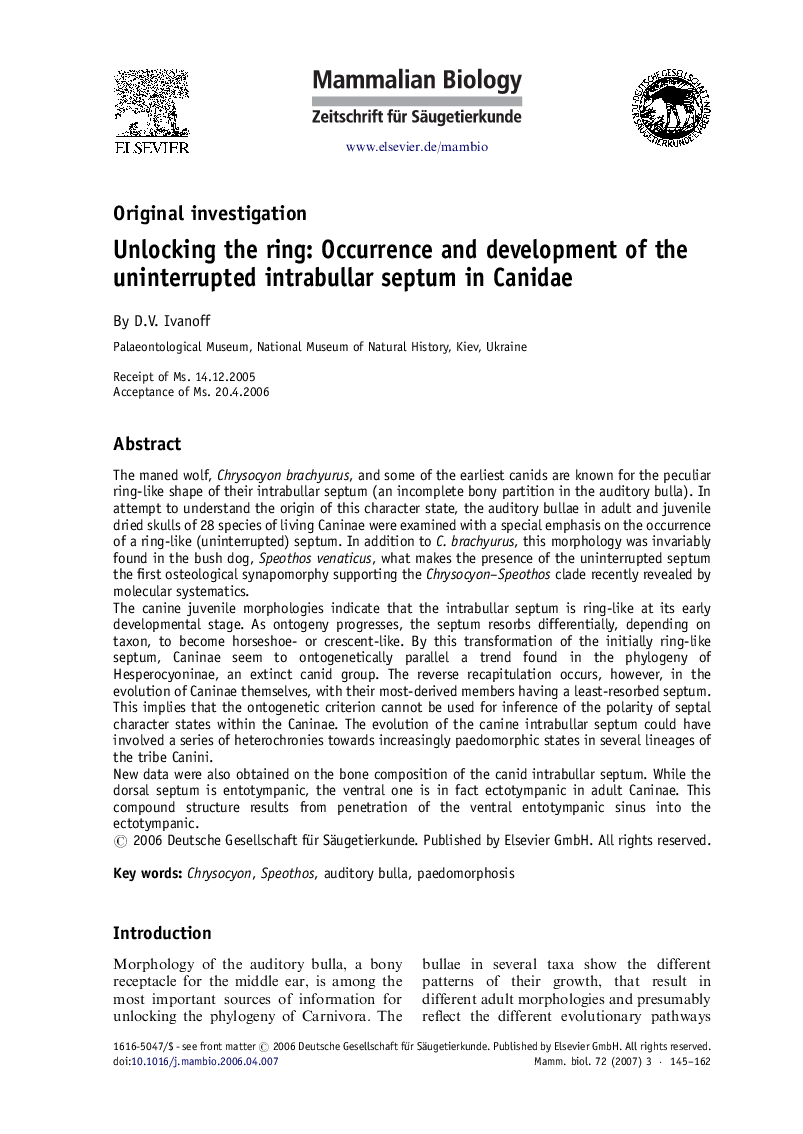| کد مقاله | کد نشریه | سال انتشار | مقاله انگلیسی | نسخه تمام متن |
|---|---|---|---|---|
| 2194465 | 1098452 | 2007 | 18 صفحه PDF | دانلود رایگان |

The maned wolf, Chrysocyon brachyurus, and some of the earliest canids are known for the peculiar ring-like shape of their intrabullar septum (an incomplete bony partition in the auditory bulla). In attempt to understand the origin of this character state, the auditory bullae in adult and juvenile dried skulls of 28 species of living Caninae were examined with a special emphasis on the occurrence of a ring-like (uninterrupted) septum. In addition to C. brachyurus, this morphology was invariably found in the bush dog, Speothos venaticus, what makes the presence of the uninterrupted septum the first osteological synapomorphy supporting the Chrysocyon–Speothos clade recently revealed by molecular systematics.The canine juvenile morphologies indicate that the intrabullar septum is ring-like at its early developmental stage. As ontogeny progresses, the septum resorbs differentially, depending on taxon, to become horseshoe- or crescent-like. By this transformation of the initially ring-like septum, Caninae seem to ontogenetically parallel a trend found in the phylogeny of Hesperocyoninae, an extinct canid group. The reverse recapitulation occurs, however, in the evolution of Caninae themselves, with their most-derived members having a least-resorbed septum. This implies that the ontogenetic criterion cannot be used for inference of the polarity of septal character states within the Caninae. The evolution of the canine intrabullar septum could have involved a series of heterochronies towards increasingly paedomorphic states in several lineages of the tribe Canini.New data were also obtained on the bone composition of the canid intrabullar septum. While the dorsal septum is entotympanic, the ventral one is in fact ectotympanic in adult Caninae. This compound structure results from penetration of the ventral entotympanic sinus into the ectotympanic.
ZusammenfassungDie Ringöffnung: Auftreten und Entwicklung des nicht unterbrochenen intrabullären Septums bei CanidaeDer Mähnenwolf, Chrysocyon brachyurus, und einige der frühen Caniden sind bekannt für ihr eigenartiges, ringförmiges intrabulläres Septum (eine unvollständige knöcherne Scheidewand innerhalb der auditorischen Bulla). Um den Ursprung dieses Merkmalszustandes zu verstehen, wurden die Bullae an 28 mazerierten adulten und juvenilen Schädeln rezenter Caninae untersucht, mit speziellem Augenmerk auf das Auftreten eines ringförmigen (nicht unterbrochenen) Septums. Außer bei C. brachyurus, wurde diese Morphologie auch ausnahmslos bei Speothos venaticus festgestellt, was das Vorkommen eines nicht unterbrochenen Septums als erste osteologische Synapomorphie ausweist, die jene vor kurzem entdeckte molekulare Systematik des Chrysocyon–Speothos-Kladus unterstützt.Die Morphologie juveniler Caninae zeigt, daß das intrabulläre Septum seit den frühesten Entwicklungsstadien ringförmig ist. Mit fortschreitender Entwicklung wird das Septum unterschiedlich resorbiert, abhängig vomTaxon, wird es hufeisen- oder halbmondförmig. Durch die Umwandlung des anfänglich ringförmigen Septums scheinen Caninae einen ontogenetisch parallelen Trend zu haben, wie er auch in der Phylogenie bei Hesperocyoninae, einer ausgestorbenen Caniden-Gruppe gefunden wird. Aber die umgekehrte Rekapitulation erscheint in der Evolution der Caninae selbst, wobei ihre am höchsten abgeleiteten Mitglieder ein am wenigsten resorbiertes Septum haben. Dies impliziert, daß das ontogenetische Kriterium nicht für die Feststellung der Polarität der Zustände der septalen Merkmale innerhalb der Caninae zu verwenden ist. Die Evolution des intrabullären Septums der Caninae könnte eine Serie von Heterochronien aufnehmen, in Richtung der immer stärker pädomorphen Zustände in einigen Zweigen des Tribus Canini.Es wurden auch neue Daten über die Knochenzusammensetzung des intrabullären Septums bei Caniden erhalten. Während das dorsale Septum bei adulten Caninae entotympanisch ist, ist das ventrale tatsächlich ectotympanisch. Diese zusammengesetzte Struktur resultiert aus dem Eindringen des ventralen entotympanischen Sinus in das Ectotympanicum.
Journal: Mammalian Biology - Zeitschrift für Säugetierkunde - Volume 72, Issue 3, 3 May 2007, Pages 145–162